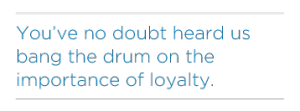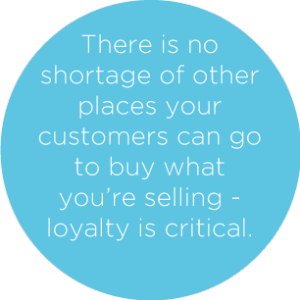For better or worse, I am somewhat of a regular at the local casino. I don’t have too many vices, and I’m always extremely responsible – I have a pre-set limit of how much I’ll allow myself to spend per visit and have only exceeded it on a handful of special occasions. Many people I know will spend much more on bar tabs or shopping sprees in a day than I will spend in two weeks at the casino, and none of them will have a chance at striking it rich…but that’s enough of me trying to justifying a bad habit of mine.
Anyway, I am sometimes chagrined at the fact that I don’t see a lot of comps or freebies thrown my way. I’m there fairly often, and I know most of the dealers by name – where’s my free meal every time I sit down?
Then I’ll see someone who comes in maybe three or four times a year, but will plunk down an obscene amount of money on the table – many times over what my limit would ever be – and receive free meals, discounts on rooms, and all sorts of goodies. And I’m reminded that although I come in more frequently, there are a ton of other gamers that spend more money than I do. THOSE are the customers worth wooing in the casino’s eyes. The same principle holds true for small business owners.
What small business owners can do to encourage customers to spend more each visit
While regular customers are undoubtedly a good sign for your business and are absolutely worth your time to cultivate, at the end of the day you’re running a business. You need money to keep your doors open, and the more money somebody spends at your place of business, the more valuable they are to your success. With that in mind, here are a few suggestions to consider in order to increase customer spending per visit.
1. Build Loyalty
If you’re a fan of this blog (and c’mon, who isn’t?), you’ve no doubt heard us bang the drum on the importance of loyalty. That’s no coincidence – it truly is that critical, especially in today’s connected world of e-commerce where there are no shortage of other places your customers can go to buy what you’re selling. You can read other entries on how to gain loyal followers, but our focus with this entry is how to increase customer spending per visit.
 Not only are loyal customers more likely to spend more money at your business because they visit more often, but they are also going to serve as your best test market to unveil new goods, new premium packages or services, and even higher prices on current goods.
Not only are loyal customers more likely to spend more money at your business because they visit more often, but they are also going to serve as your best test market to unveil new goods, new premium packages or services, and even higher prices on current goods.
You have already earned their trust and loyalty – the hardest part of the battle is over and you are the victor who earns the spoils. Try out a new premium, high-priced item with your most loyal consumers and inform them that they are part of an elite member of people that gets first crack at it before anyone else does. Not only will this make them feel elite and a valued part of your business (which they are), you will also be able to see how successful this new product or service you’re about to debut is. Keep in mind though, that loyal customers are MUCH less sensitive to higher prices than infrequent or completely new customers.
2. Package Your Goods
“Would you like fries with that?” is synonymous with package deals – burger purveyors from long ago realized the value of bundling their goods together, which is why you would be extremely hard pressed to find a fast food chain that didn’t offer some semblance of a value meal. Burger, fries and a drink may not be what you’re selling, but don’t overlook this tried-and-true mechanism of increasing customer spend amounts.
 Some packages just make sense, plain and simple. If your business is in the outdoor and hiking/backpacking trade, you probably sell your fair share of sleeping bags and tents. You also probably sell a decent amount of backpack water purifiers and hiking poles. Many of your customers are probably purchasing an item or two for a backpacking trip – why not combine them and offer a slight discount on both? If your customer buys a winter-rated sleeping bags, why not offer to throw in a set of hiking poles for 25% off? They may very well be in the market for the poles as well, and a small discount certainly won’t break your bank.
Some packages just make sense, plain and simple. If your business is in the outdoor and hiking/backpacking trade, you probably sell your fair share of sleeping bags and tents. You also probably sell a decent amount of backpack water purifiers and hiking poles. Many of your customers are probably purchasing an item or two for a backpacking trip – why not combine them and offer a slight discount on both? If your customer buys a winter-rated sleeping bags, why not offer to throw in a set of hiking poles for 25% off? They may very well be in the market for the poles as well, and a small discount certainly won’t break your bank.
Another tactic to consider when it comes to bundling is to offer extreme discounts on items that you’re struggling to move off the shelf. If you have a plethora of mosquito netting that you just can’t seem to offload, try offering it for 75% off with any purchase over a certain dollar amount. You may not be making as much (or any) money off the netting, but at least you’re reducing your inventory and making shelf space for something that will (hopefully) sell better.
3. Raise Prices
This is often seen as tremendously scary territory for small business owners – after all, consumers can be notoriously sensitive to increased prices and rightly so. But instead of viewing it as simply raising prices without cause, try and think about what kind of value and results you are providing to your customers, in addition to your goods and services. It can be wise to try and match your prices to be in line or under what your competition is offering, but don’t you feel your offerings are superior to theirs?
Try toeing the waters first with small increases – something as little as one to five percent on a basic or entry level item that is purchased often. Give it a few months or at least enough time to gather a large sampling pool. Compare this data to your previous, lower price and compare. Did people run for the hills in disgust at the increase in price? Odds are good they did not, but at least with measurable data you’ll be able to see if the increase was worth it or not. Experiment with different prices – as long as you give them enough time to find a foothold, you’ll find that the market will dictate the sweet spot in terms of pricing.
Happy and comfortable customers spend more, use that to your advantage
In addition to some of the more straightforward tactics mentioned above, there are a few seemingly non-sequiturs that are worth mentioning:
4. Smells Good in Here
If you run a bakery, cologne shop, or potpourri emporium, you can skip right over this – but for other small business owners, do not overlook the importance of a fragrant physical storefront. Studies by marketing services company DMX and the Smell and Taste Research Foundation have both shown that customers are not only more likely to make purchases in a pleasant-smelling environment, but are also willing to spend more money for the same item. The most popular fragrances to open up the ol’ wallet? Coconuts, flowers, and tropical gardens.
5. Let the Sunshine In
People tend to be happier in sunshine, and when people are in a better mood, they tend to spend more. A study conducted by the University of Alberta found strong empirical evidence that customers who shopped in an area with more natural light were more likely to make a purchase and spent more per visit – in some cases, as much as 56% more. Take advantage of sunny days and consider splurging on one-time upgrades such as skylights or additional windows.
 6. Chill Out
6. Chill Out
The expression “Don’t sweat it” is usually uttered to someone who is worried or stressed about something – that’s because when anxiety or apprehension sinks in, our heart rate tends to increase, which in turn increases or temperature, and thus causes the body to respond by perspiring to cool us down. Whether or not we realize it or not, when we’re warmer, we are perceivably less likely to make complex decisions (such as decide if something is a good deal or not) than we are when we’re cooler.
Translation? People spend less when they are hot, according to a study conducted by Virginia and Houston universities. When the hotter months roll around, don’t be a miser and try to skimp on the AC – your bigger utility bill may very well be offset by bigger purchases from your customers.
If each loyal customer buys just one more item than usual, it will add up
Not everyone that is a patron of your business will turn be a big spender – most just simply aren’t going to frequent your place of business often enough to even qualify, and many that do won’t have the budget or spending habits to fit the bill. Try not to think of the above ways to reel in “big fish” that will bring in half of your month’s revenue each time they stop by. Instead, think of them as ways to turn somebody who usually purchases three items for around $20 into someone who usually purchases four or five items for $25 or $30. It may not seem like much at the time, but it all adds up and more importantly, adds to your bottom line.






Leave a Comment